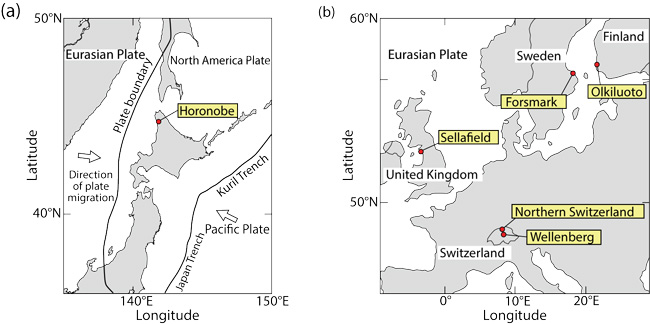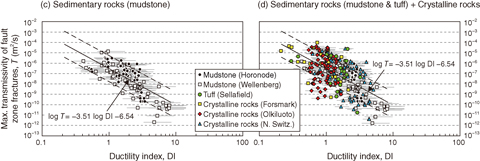
Fig.8-20 Six areas that were studied

Fig.8-21 Relation between the maximum transmissivities of fault zone fractures and ductility index values
Spatial and temporal prediction of the transmissivity of underground fault zones based on limited data is an important problem in high-level radioactive waste disposal. To develop the prediction methods, this study compiled various experimental data obtained from areas in Japan and abroad in relation to fault zone transmissivity, and successfully revealed a new relation helpful for the prediction.
Borehole data obtained from six areas (Fig.8-20) in different geological environments, namely, Horonobe (Japan; mudstone), Wellenberg (Switzerland; mudstone), Sellafield (UK; tuff), Forsmark (Sweden; crystalline rocks), Olkiluoto (Finland; crystalline rocks), and Northern Switzerland (crystalline rocks), revealed that the maximum transmissivities of fractures in fault zones are strongly controlled by their ductility index (DI) (Fig.8-21). DI is a new indicator and is defined as the effective mean stress normalized to the tensile strength of the intact rock. The effective mean stress refers to the average stress that is actually loaded into a rock, and the tensile strength refers to rock strength against tensile failure. DI is a parameter that can be spatially and temporally predicated from information such as a geological map and the local tectonic evolution.
The results of this study mean that DI and the relation shown in Fig.8-21 allow for the spatial and temporal prediction of the maximum transmissivities of fault zone fractures in a rock mass. Since the studied fault zones have experienced many fault movements in the past, it can also be suggested that the maximum transmissivities of the fault zone fractures do not irreversibly increase beyond the above relation, even with fault movement.
The finding of this study allows for the spatial and temporal predictions of underground fault zone transmissivity and may prove helpful for various geoscientific/geoengineering problems as well as geological disposal. This finding will be further studied in the Horonobe underground research laboratory by in situ tests in the underground (e.g., a hydraulic disturbance test for a fault zone) and laboratory tests, leading to a demonstration of the buffering ability of sedimentary rocks against tectonic movement.